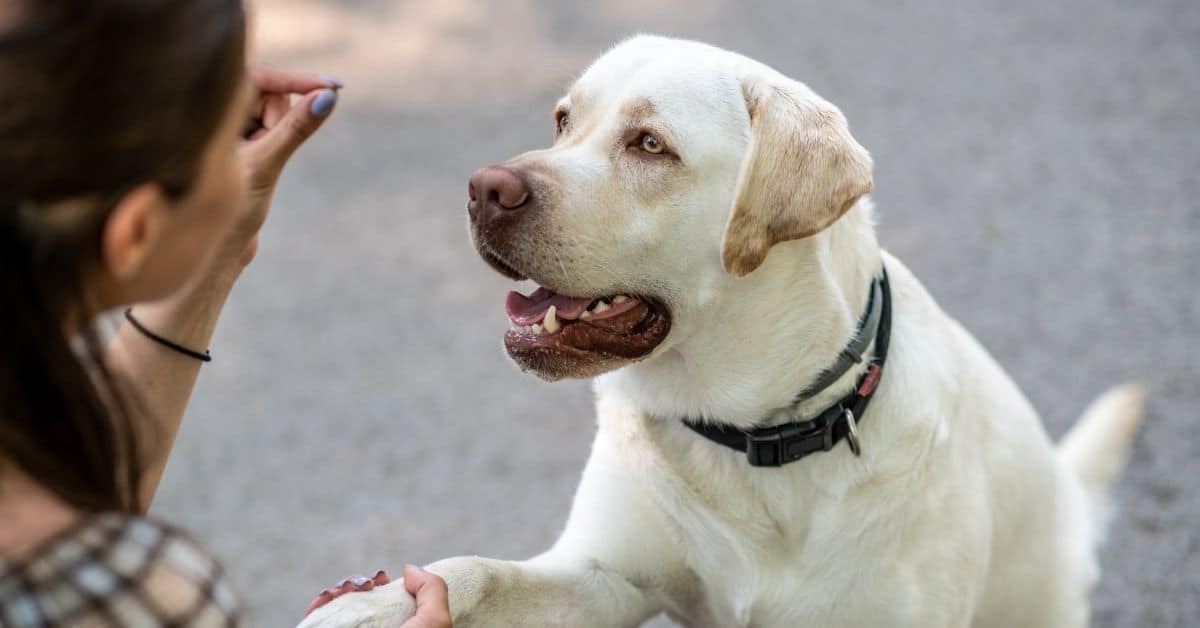Are you all set to start training your dog?
It’s crucial to get your dog trained as quickly as possible.
They ought to be able to sit, stay, come to their crate, go potty outside, and all those things.
And, believe it or not, even a beginner can do it themselves. If you are training a dog for the first time, or just looking for some helpful tips and tricks, here are some to help you along the training process.
Dog Obedience Program: Learn how to make the fundamentals before starting a training session with your dog.
Use Games to Train Your Dog: Dog or Puppy training should be full of fun!
Try to include some games in your dog training session.
It is as you and everyone know: learning is more accessible when you are having fun.
6 Weeks for a Well-Trained Dog: From puppy training to a service dog in about six weeks.
Using this schedule as a guide, you can teach your dog the basics of how to behave.
How Should You Train Your Dog?
Most people adore their furry friends.
Not every moment is enjoyable and full of fun.
Are you asking yourself which method is best, and how do you apply these skills?
There are typically two methods used to train a dog:
The first is the aversive-based method.
When you train your dog using unpleasant methods, such as positive reinforcement or negative punishment, you are engaging in training that is known as aversive-based.
The second is the reward-based method.
This is the technique based on treats to praise your dog for doing what you want to do.
Understand How Your Dog Learns
Dogs learn a lot like tiny toddlers.
As they mature, they begin to comprehend our language.
Some intelligent breeds can answer up to 250 basic commands!
Their IQ is comparable to that of two-year-old humans; they care about immediate repercussions.
Scientists have identified three categories of dog intelligence.
1. Instinctive
Instinctive learning occurs when a dog acquires the habits he was bred for.
2. Adaptive
Adaptive learning is the degree to which your dog learns from its surroundings and environment to solve challenges.
3. Working and obedience
Working ability and compliance determine how successfully they understand the jobs and directions you instruct them.
Basic Commands and Fun Tricks
Every dog should be familiar with the basic commands and dog tricks that are used in a dog training session.
Those commands are “come,” “sit”, “drop it”, “stay”, and “back up”.
Teaching new tricks is an excellent method to provide mental stimulation for both of you.
Name Recognition
You train your dog to respond to its name first.
Whenever you get a brand-new puppy, one of the first things you should do is teach them their name.
It will be helpful in every training session as a simple practice to get their attention.
Always ensure that their name has a good connotation rather than one of punishment so that they respond positively to it.
Leave It Or No
“No” is a universal command for whatever you do not want your dog to do.
Expert Trainers adhere to “No” to maintain simplicity and avoid confusing people and animals.
Some trainers instruct both “No” and “Leave it” for slightly distinct circumstances.
Lie Down
Teach your dog to lay down.
This is an important trick to help get your dog to relax.
Trainers relate their preferred dog training method to removing the keys from an automobile’s ignition.
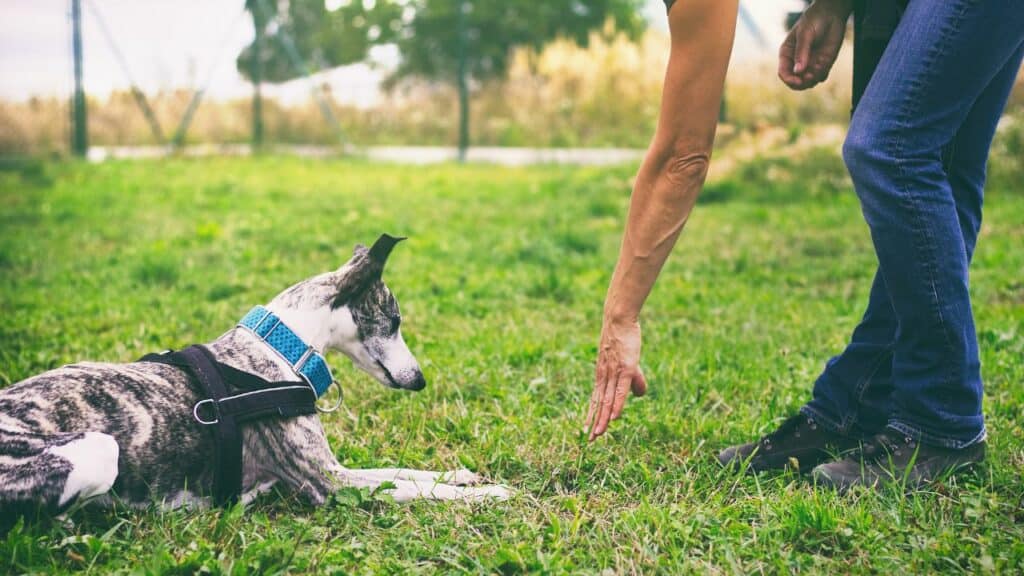
Stand
This technique may appear to be something best left to experts during dog training, but it is certainly achievable if you are a persistent, patient, and determined dog owner.
This trick may appear difficult in contrast to “Shake Hands” or “Spin”. but it is just as simple to do if you put in the time and effort.
Related: How To Teach A Dog To Shake
What’s The Best Way To Train A Dog
You will likely train when you get a puppy or an adult dog.
To become a decent canine citizen, a well-mannered puppy or dog must listen to commands.
The owner imparts these skills to all his pets to keep them safe and well-behaved.
With 10- to 15-minute daily practice sessions, most dogs can get these fundamental abilities within a week or two.
Sit-Stay
Sit should always be taught since it is the most intuitive idea for most dogs.
You will then need to teach them several new behaviors and refrain from unwanted behaviors, such as laying down and shaking hands.
It is also useful when meeting a new person or dog to refocus their enthusiasm.
Wait
Your dog should be waiting before going to eat.
You may use this order to temporarily prevent your dog from pursuing anything, such as its meal.
It is handy for configuring unwanted behaviors and problem behaviors.
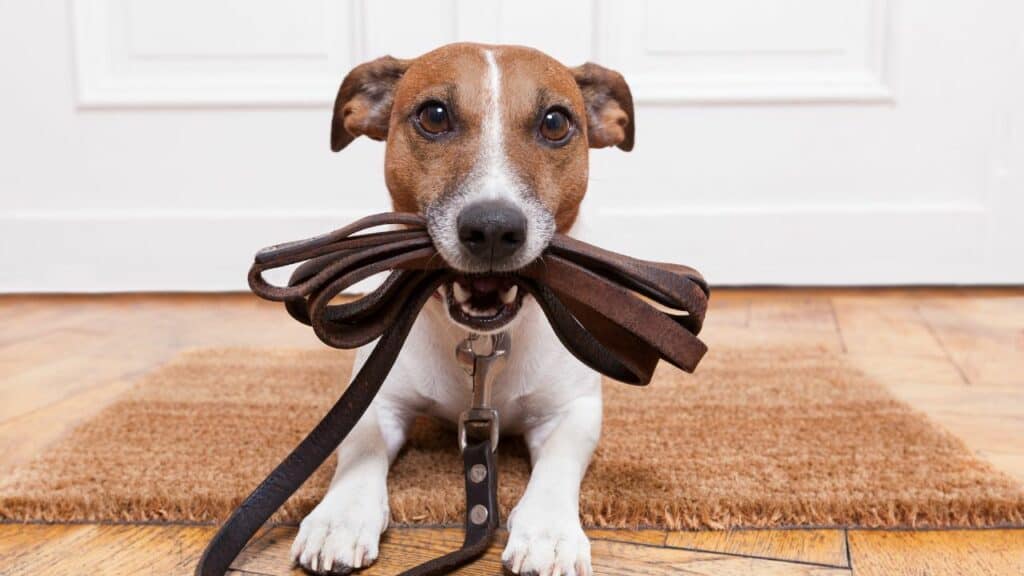
Heel
All dogs should be taught to heel or walk gently at your side.
The tip is especially crucial for large or strong dogs that tug on a leash by nature.
Once a dog can heel, walks will be easier and more enjoyable for both the dog and the owner.
Take It And Drop It
Get your dog to ignore an object.
Have your dog take an item in their mouth.
This straightforward command is excellent for teaching your dog to grab an object, such as a ball or toy.
On a stroll, your dog frequently discovers something they shouldn’t, such as a personal item or an animal.
This is a valuable technique to teach your puppy from a young age.
Come
If you intend to take your dog off-leash, he must know how to respond to its name.
It can keep him safe if a fight breaks out at the dog park, keep him away from the street if he escapes the leash, or keep him near when hiking or playing in the backyard.
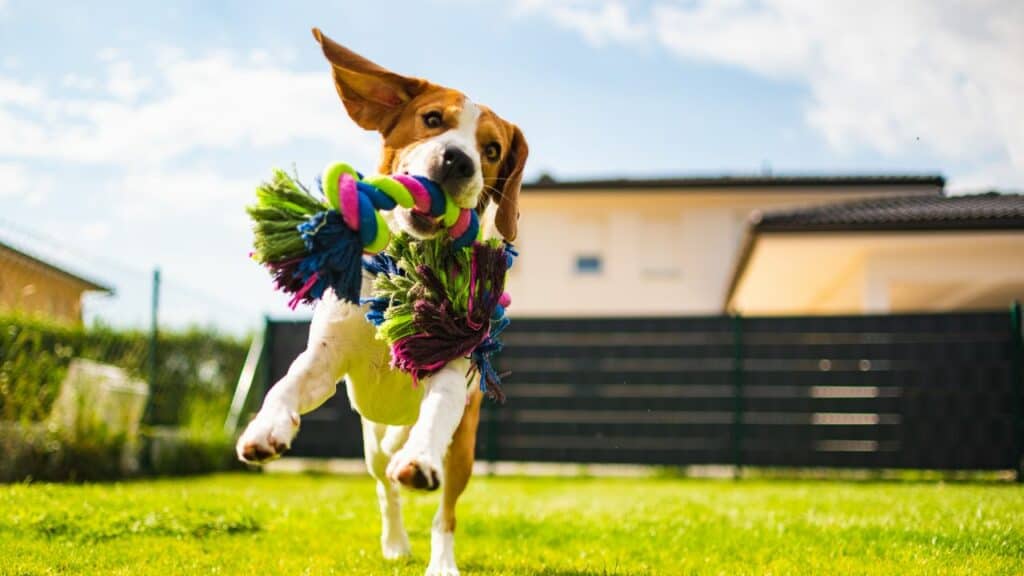
Watch Me Or Look
A “Watch Me” signal helps you to direct your dog’s attention during training sessions, which is vital.
A pet not paying attention will not see what you are doing.
But one who observes you is anticipating your later request.
Controlling your dog’s gaze will boost your effectiveness, mainly when using lure-and-reward training or teaching hand signals.
Crate Training Process
Even if you want to keep your dog outside, you will still need to educate it on where to defecate so it will be in the appropriate location.
Crate training should thus be one of the first things you do with your dog after getting them.
This encompasses many different aspects of training, including (but not limited) to house training.
It will aid in housebreaking and provide your pet with a private place to relax.
Leash Training Dogs and Puppies
The ability to run well on a leash is a must for all dogs.
The inability to walk correctly on a leash is a severe problem for all dogs.
Please keep your dog on a leash to protect him because most places have rules about dogs on leashes.
Determine how you’ll get the dog or puppy acquainted with the leash and afterward teach him to walk correctly while linked to it, even when riding a bike.
You will have a much better time on walks when your dog learns to walk calmly and without pulling or lunging at other pets or people.
How To Socialize
Exposing your dog to new people, other animals, and surroundings is what’s meant by “socialization.”
Dogs who have been adequately socialized are less likely to display problem behaviors and are more likely to find acceptance in the community.
Fears and phobias are less likely to form if humane society gets out more.
Puppy
While laying the foundation early on is essential, you should not neglect your puppy’s training during the early life of adolescence and adulthood.
Treat your pup with tasty, soft goodies regardless of whether he chooses to interact with you.
Adult Dog
Socialization in adult dogs is more complex than in puppies.
An older dog is less likely to take to novel situations eagerly.
Most trainers agree that gradually exposing a dog to possible triggers and praising calm behavior with a combination of goodies and treat is the best approach.
Clicker Training for Dogs
A popular kind of “positive reinforcement” called “clicker training” is an easy way to teach a dog new behavior.
Although you can certainly train your dog without a clicker, many owners have found that it speeds up the process and produces better results.
You may teach your pet any number of instructions and tricks, from the most elementary to the most complex, using only clicker training.
Clicker training your dogs is a quick and simple process to master.
Proofing Behaviors and Troubleshooting
When training your dogs to do a new behavior, the final stage is proofing.
Finally, after you’re done teaching your dog a new trick, it’s time to have them “prove” it.
Master the art of “proofing” your dog’s manners so he’ll be just as well-behaved in public.
The following guides will assist you in navigating this part of the training phase:
Proofing Behavior: Conduct practice sessions for the desired behavior in various settings with various levels of interest.
Self-Control Training: You may use this method to teach your dogs that they must earn rewards like food and attention via good behavior.
Common Dog Behavior Problems: During dog training, when a trainer has a better understanding of the potential behavioral problems, you will be better able to see them and handle them before it gets late.
Helpful Training Equipment
Being a dog owner, whatever method you use to teach your dog, you’ll need a few dog sports equipment to make the process easier.
A collar, a standard 6-foot leash, a long line, goodies, a treat bag, a clicker, and some durable walking shoes are included (for you).
Additionally, there are a few products that most owners will find helpful, if not essential to learn their dogs.
These contain items such as a container, a training mat, a muzzle, and others.
Clicker
A dog trainer uses smartphone clicker apps and clickers with various sounds for each dog.
A clicker may say both cued and natural desirable mental stimulation.
Handheld and wrist-strap clickers are available. Some leashes have clickers.
Treats
Dog treats keep him motivated.
Soft, meaty snacks are often dog favorites.
Small joys, like a pencil eraser or blueberry, are best.
Some training rewards are pre-sized, whereas must chop down others.
Portable mat
A portable mat or bed gives your dogs a safe place to rest.
Foldable, washable beds, carpets, and blankets are great for trips.
Sticky-bottomed varieties are more stable on slippery surfaces.
Leashes
A training leash will generally be between four and six feet in length.
Your dog should be on a leash that is just long enough that there is some slack while walking near you.
Dog Training: Obedience Training for Dogs
When you are training your dog to be obedient, you should focus most of your attention on training methods involving obedience tactics and the precise actions you desire from them.
Your dog will have more freedom to engage in activities that they like, such as running off the lead and accompanying you to meet members of your family if you instruct them in the fundamentals of obedience.
This will ensure that they remain safe and under your control.
Observation during dog training centered on rewards rather than punishments does not teach your dog to react out of fear.
Obedience Training With Rewarding
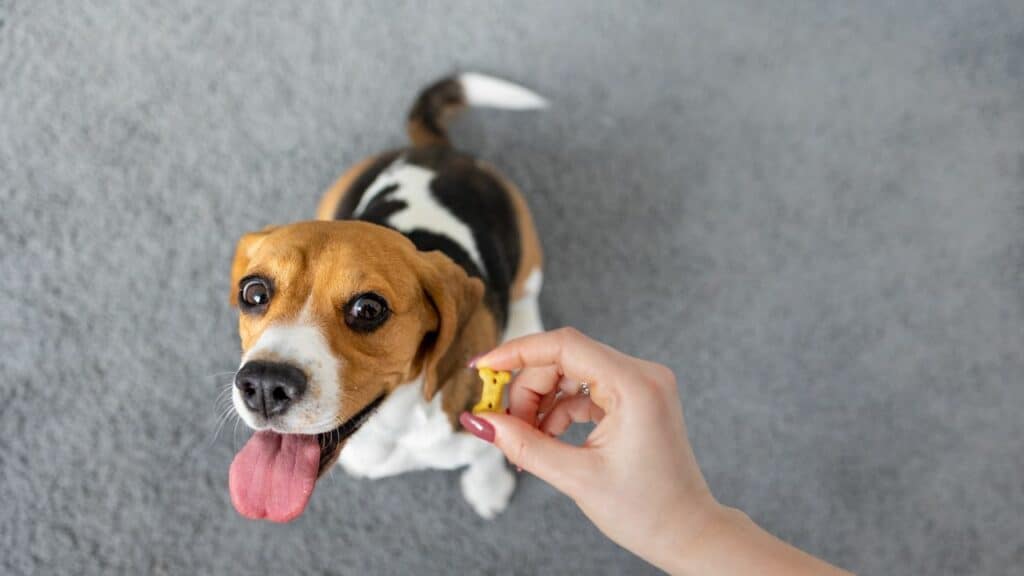
Suppose you are interested in teaching a dog to do a particular activity.
In that case, one of the most efficient ways is to reward the dog with food, praise, or love after completing the behavior in question.
As a trainer, your primary concern should be to ensure that you routinely praise and reward your dog for behaving as you like.
It would help if you awarded your dog once he has completed the behavior you have asked of them.
Do not give positive reinforcement to unwanted behavior.
Which are the best ways of rewarding your dog?
To be successful with reward-based training skills, your dog must learn that behavior problems will result in negative reinforcement instead of positive reinforcement.
Here, the punishment for poor behavior is to withhold the reward.
You may use bait to help your dog get into position or to lead it through the motion of the activity.
Using a treat as a lure, in which the hand holding the treat is closed, allows the dog to be guided into the appropriate posture.
Smelling the reward increases the likelihood that a dog will follow a food lure, and if you can direct their head, you can control the rest of their body.
Basic Potty Training
How to house train your dog: house training isn’t hard, but it’s not precisely while walking in the park.
Your dog/puppy’s success in in-house training depends on your dedication, consistency, and patience.
During housebreaking, consistency and perseverance are essential.
While mishaps are inevitable, these dog-safe house training tips will help you get your new family member off to a good start.
When you start to house train, follow these steps:
Maintain a consistent feeding plan for the pup and deprive them of food between meals.
Take the puppy outside for a bathroom break first thing in the morning and once every thirty to sixty minutes.
Bring them out after meals and when they get up from naps.
Take the puppy to the exact location so they know where to relieve themselves.
Stay by them outside, at least until they have completed their training to use the restroom.
Give your puppy a treat or praise them when they go potty out.
Control Consequences Effectively
According to American Kennel Club, to be successful with reward-based training, your dog must learn that inappropriate behavior will result in negative reinforcement.
An older adult may be in danger from a dog that has the habit of jumping on visitors.
By ignoring those when they leap up, you can teach them to stop doing so in the future.
Hold on to a snack as you work. Repeat this process until your dog is no longer jumping to greet you when you enter the room, and reward it when it succeeds.
Then they’ll know to reward your dog for good behavior with the goodie you brought.
Training New Skills
You and your dog can go on to more complex tricks once you’ve mastered the basics.
Your dog’s physical and mental faculties will both enjoy these activities.
Plus, they’ll help strengthen your friendship with your friend.
Training is something that should think of as ongoing.
Ultimately, you will never be done.
Maintaining your dog’s obedience skills is one of the essential tips.
If a person learns a language as a youngster but never uses it again, they risk forgetting a lot of the language as an adult.
Your dog is no exception; exercise it or lose it.
Even the most fundamental commands and tricks will be easier to remember if you learn them with your dog.
And it’s a fantastic way to bond with Fido.
We hope these guidelines/ tips will be helpful for you as an owner to teach and learn your dog.
But we highly suggest enrolling in a dog training class if you want to learn more than the basics and go into advanced techniques, such as clicker training.
Following methods you should use while training your dog to learn in a befitting manner:
Cut distractions: New training should always begin in a private, distraction-free space.
Bet for it is your dog’s home.
Training should be broken up into short, consistent sessions.
That way, your dog doesn’t become overwhelmed.
Be patient – Like humans, dogs may learn at varying speeds, so don’t be frustrated if your pet seems slow to catch on.
Always conclude on a high note by reinforcing something your dog already understands.
Have fun – Together, you and your dog can grow closer via training!
If you have any problems, try asking a qualified trainer for advice.
Before You Go…
Now you know the essential parts of dog training.
If you want to learn more, read the following article too!

